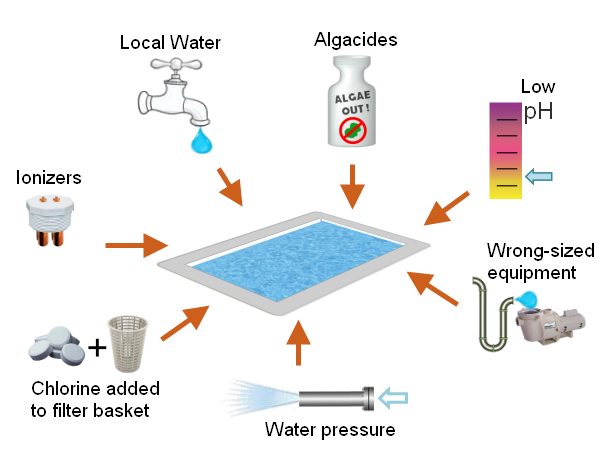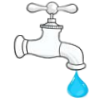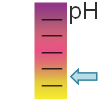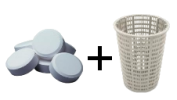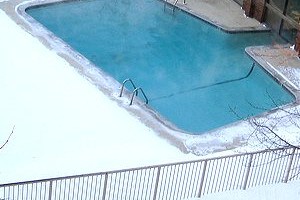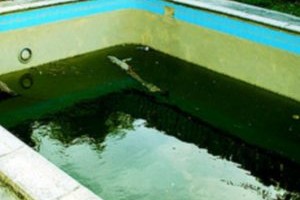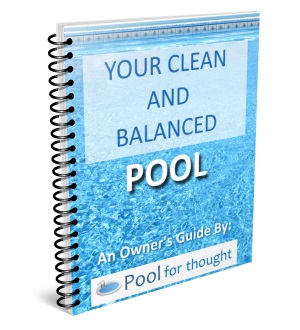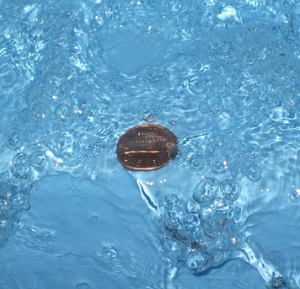
If you have ever looked down into a wishing well or any public fountain, you might see plenty of coins tossed in by other people. You can easily spot pennies that have been in the water a long time, as they are often green-gray in color. That colored material on the penny is a signal the water is actively dissolving the surface of the coins.
Metal exposed to your pool water is no different, and is only one source of dissolved metal in your pool water.
In this article, I discuss all the common and not-so-common ways copper can find its way in your swimming pool. In another article, I explain how to test the copper level in pool water, and if you do have copper in your water, how to lower copper in your swimming pool.
Importance for your pool
How can copper appear in your pool water? Even perfectly balanced swimming pool water can have copper problems. There are multiple ways copper can enter your pool water, which I illustrate below:
Cause: Your local water source.
Your local water source alone can supply enough copper that over time can build up enough to become a problem. Copper and other metals and minerals are naturally found in your water source. The local water municipality usually only filters enough metals and minerals out to keep levels down to acceptable drinking water standards. After all, the primary concern by the water municipality is your health, not the health of your pool. Well water is just as bad, and often times much worse.
Concern: A continuous source of copper in your pool.
Each time you add water to the pool, a little more copper is added. This copper builds up over time. How fast depends on the copper content of your water source. My municipal water utility company sends out an annual water analysis every year. If you also get one of these, it’s worth a quick look to see how much copper is in the water. The United States Environmental Protection Agency regulates the level of copper in drinking water at a national level, which is 1.3 ppm (parts-per-million). This is over six times the maximum recommend level of copper (0.2 ppm) in your pool water! So, if you local source is anywhere near the national maximum copper level, your pool is going to naturally gain copper.
[sc:ad_leaderboard_google]Cause: Algaecides to control pool algae growth.
Algae growth in a pool is inevitable. Warm, uncontaminated swimming pool water is a great place for algae to grow. Algaecides are the preferred method to effectively control algae growth, but some of the most effective ones are copper-based. The algae is killed when they ingest algaecide containing copper-based molecules.
Concern: Requires additional water testing and copper removal.
If you have challenges with algae growth, then algaecides are your best option. There are two main types, those with sequestering or chelating agents, and those without. The algaecides with the sequestering agents help keep the any copper in the algaecide from going out of solution. Stronger algaecides, like those used to combat black algae, often do not contain the sequestering agents, as you want the maximum killing power. The problem with these is you have to add your own sequestering agents separately as much as one week later to make sure you give the algaecide time to work, yet not too long as to let the copper build up out of solution and stain the pool.
Shocking your pool with chlorine-based shock can also rid many types of algae from your pool, but there are chlorine resistant varieties and those which actually consume some of the chlorine you add. Excessive algae growth can also be a cause of combined chlorine in pools, resulting in a high chlorine demand. This means you have to add much more chlorine to the pool water to achieve the same sanitizing effect.
The bottom line is if you use copper-based algaecides, then you have to test for copper more often. If you discover excessive copper in your pool, then you need to add a copper sequestering or chelating agent to keep those metals in solution.
Cause: Low pool water pH.
In my article, lowering swimming pool pH, I discuss how pool water with a low pH can cause metal pool surfaces to corrode. Low pH water is acidic, and the stronger the acid, the faster metal corrosion will take place.
Concern: Low pH dissolves metal in pool equipment.
It’s bad enough the the corrosion is happening, which looks unsightly, feels rough, and looks like you don’t maintain your pool very well. What is worse is the corrosion process dissolves some of the metal into the pool water. For parts that contain copper, like metal piping in older pools and copper heat exhangers in pool heaters, small amounts of copper from these surfaces will be released into the pool water. It depends on how low your pH is, how long you pool has had the low pH, and how much metal is exposed to the pool water to determine how much copper is being released into the pool.
[sc:ad_leaderboard_google]Cause: Improperly-sized pool equipment and plumbing.
If the pool motor is sized too powerful or the pipes and fittings are too small, this can cause the water to run at higher pressures than is recommended. Not only will this strain the equipment, causing gaskets and seals to degrade faster and leak, but this can also affect your pool water.
Concern: High velocity water over surfaces can release copper over time.
Copper is a softer metal than steel or iron. Over time, this high velocity water can wear the metal surfaces, causing cavitation. The surfaces might still appear fine when looking at them, but under a microscope you would see small wear spots on the metal surface where the water pressure increases and decreases repeatedly. Over time, the cyclic pressure stresses the metal to the point small amounts are released and then dissolved in the pool water. How do you know your pool equipment is sized correctly? A pool professional can tell you that, based on the size of the pool and the size of your pool equipment.
Cause: Dumping chemicals or dropping chlorine tablets directly into your pool skimmer.
Unless you are using chlorine (trichlor) tablets or other chemicals specifically designed for pool skimmers, never add chemicals in the pool skimmer.
Concern: Excessive build-up of chemical in the pool skimmer location can corrode pool equipment.
Placing a couple chlorine tablets in the pool skimmer seem like an easy way to give the water a boost if you need extra chlorine. The problem is that the pool skimmer water travels next to the pool equipment, with your expensive heater and piping the first to come in contact with this highly chlorinated and corrosive water. The same goes for chemicals that lower pH, total alkalinity, or calcium hardness. If your pool pump has a timer where the pump only runs at certain times during the day or night, then the problem is even worse. If the chemicals were added when the equipment is off, the chlorine tablets would sit in the pool skimmer water and the levels will build as the tablets dissolve. Once the timer turns the pump on, you have hyperchlorinated water headed straight for your equipment. It’s likely very minimal corrosion occurs during this time as the water passes quickly through the equipment, but if this happens every day then the damage can stack up over time.
Cause: Using a water ionizer.
You might use a copper/zinc ionizer in addition to chlorine to sanitize the pool.
Concern: Copper/Zinc ionizers can introduce copper into the pool.
These devices can inject copper into the pool water in the course of their normal operation. If used properly, these devices should not cause a problem. Follow the manufacturers directions to make sure you are not adding to your copper problem. When using an ionizer, keeping your pool water balanced is even more important, as imbalanced water can degrade these devices, shortening the cartridge lifespan and adding metals into your water.
[sc:ad_leaderboard_google]Conclusion:
As you can see, there are numerous ways for copper to find its way into a pool. Even healthy pools with perfectly balanced water can have issues with copper. You need to test your swimming pool copper level, and if your pool test reveals copper present, then you need to lower the copper level in your pool.
Source:
- “Environmental Protection Agency, Basic Information about Copper in Drinking Water”, https://water.epa.gov/drink/contaminates/basicinformation/copper.cfm
Photo credits:
[sc:Mailchimp_bottom_post param1=”Manage Pool Water Copper”]